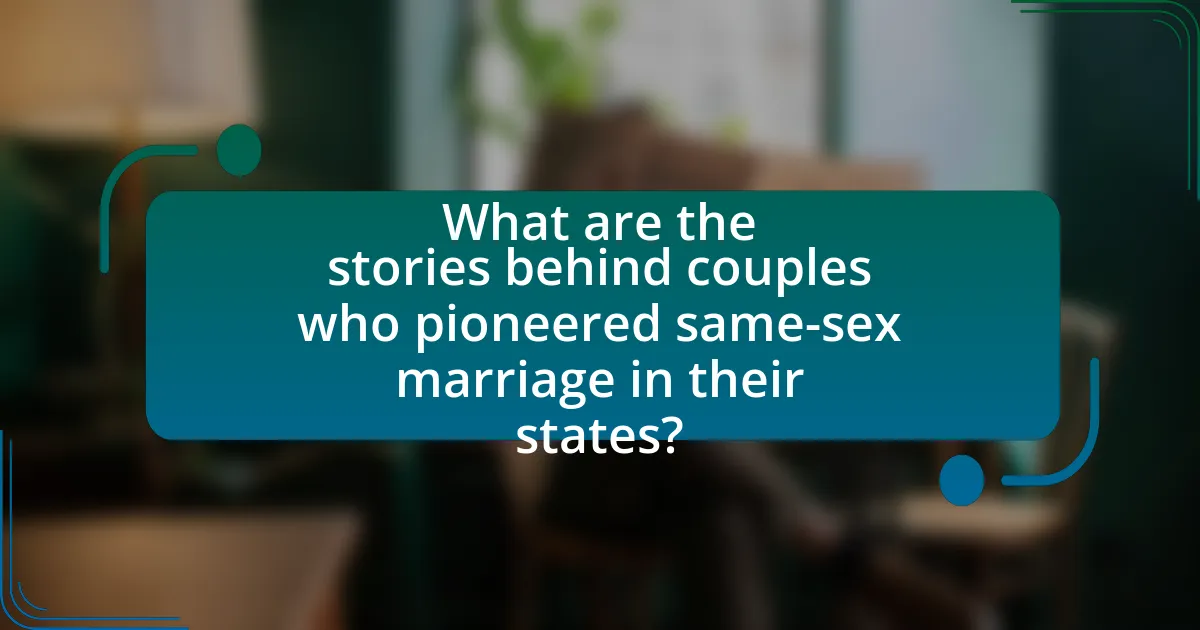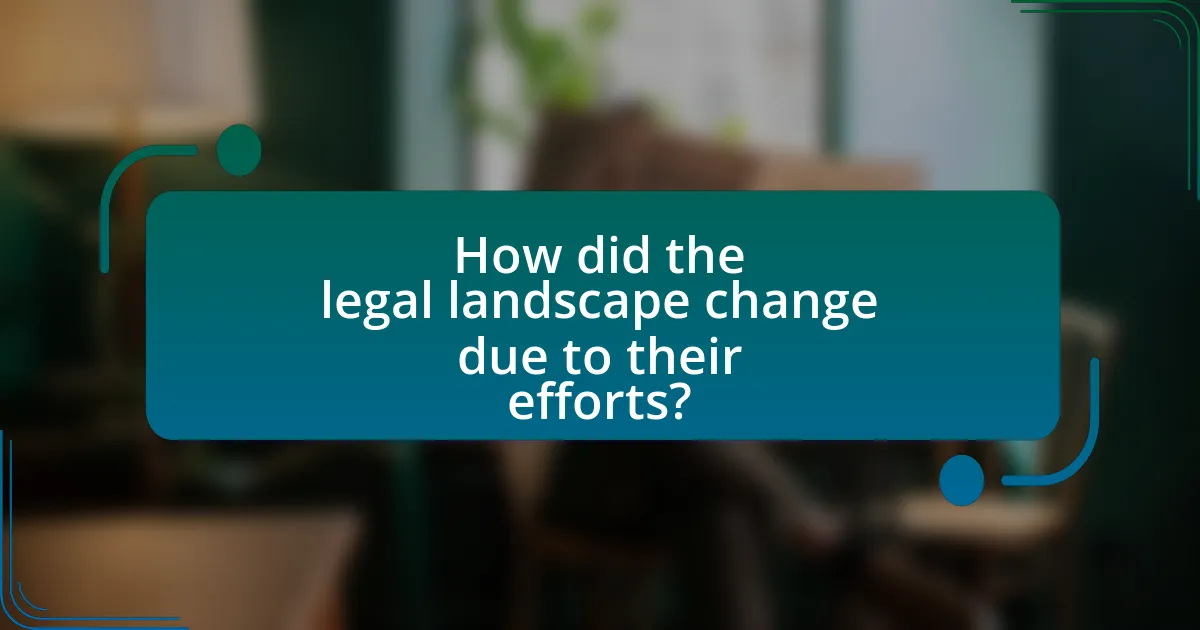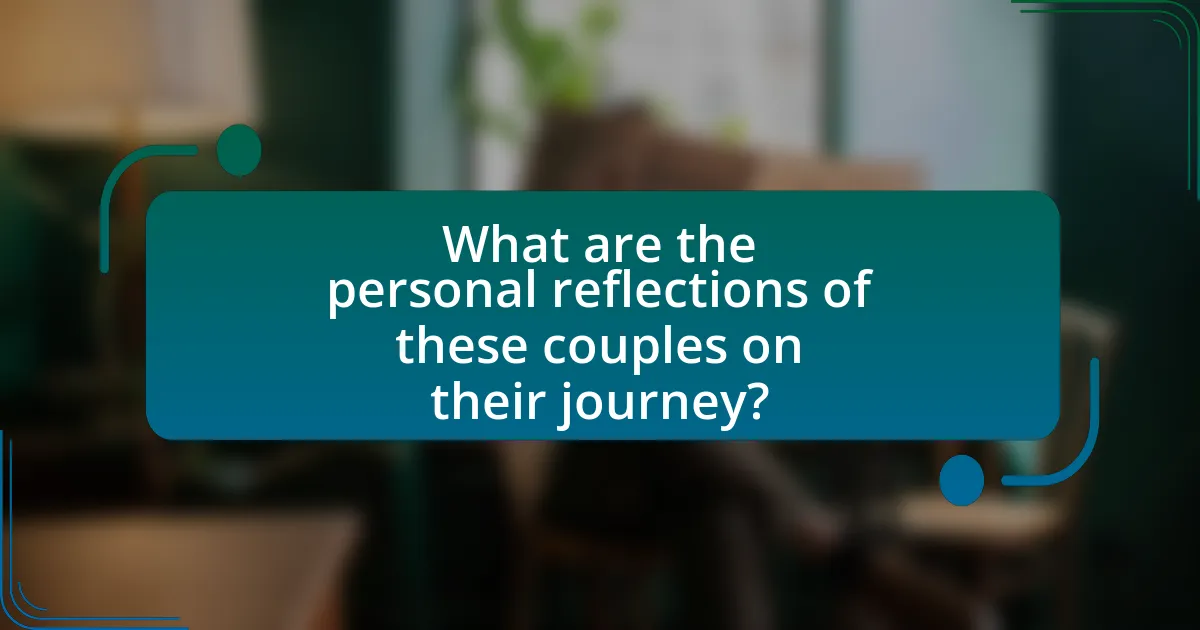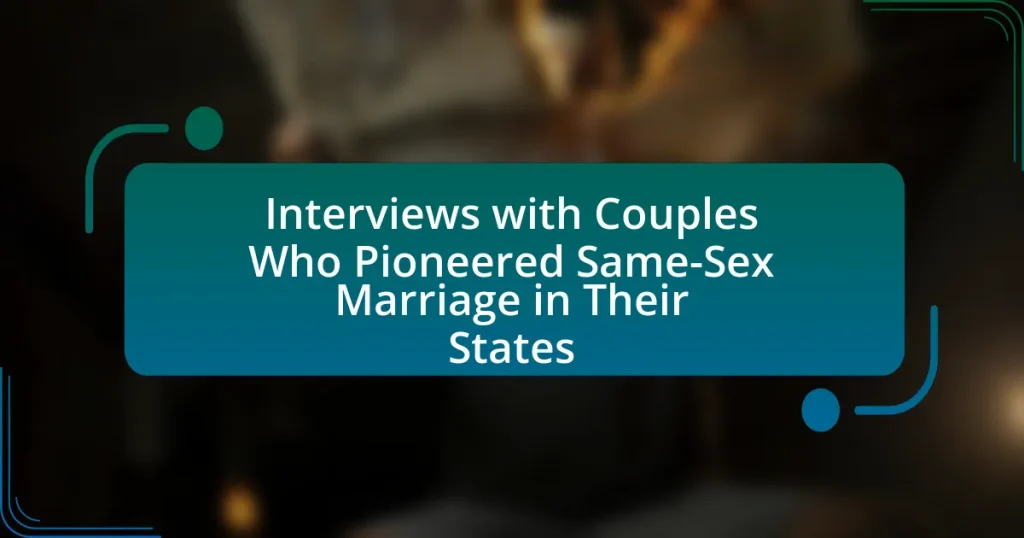The article focuses on couples who pioneered same-sex marriage in their respective states, detailing their personal stories, legal battles, and advocacy efforts that led to significant changes in marriage equality laws. It highlights key cases such as Goodridge v. Department of Public Health in Massachusetts and Obergefell v. Hodges, illustrating the challenges these couples faced, including legal discrimination and societal opposition. The piece emphasizes the impact of personal experiences on their activism, the role of public opinion in shaping legal outcomes, and the strategies they employed to garner support for their cause. Additionally, it reflects on their contributions to the marriage equality movement and offers insights into their emotional journeys and advice for future advocates of LGBTQ+ rights.

What are the stories behind couples who pioneered same-sex marriage in their states?
Couples who pioneered same-sex marriage in their states often faced significant legal and societal challenges, yet their determination led to landmark changes. For instance, in Massachusetts, the case of Goodridge v. Department of Public Health in 2003 involved couples like Julie and Hillary Goodridge, who fought for the right to marry, ultimately resulting in Massachusetts becoming the first state to legalize same-sex marriage. Their story exemplifies the personal sacrifices and public advocacy that characterized the movement, as they sought legal recognition for their family and love. Similarly, in California, the case of Perry v. Schwarzenegger featured couples like Kris Perry and Sandy Stier, whose legal battle in 2010 challenged Proposition 8, leading to a federal court ruling that deemed the ban on same-sex marriage unconstitutional. These couples’ stories highlight the intersection of personal experiences and broader social movements, illustrating how their courage and commitment to equality catalyzed significant legal reforms across the United States.
How did these couples become advocates for same-sex marriage?
These couples became advocates for same-sex marriage primarily through personal experiences of discrimination and the desire for legal recognition of their relationships. For instance, many faced challenges such as denial of spousal benefits, hospital visitation rights, and legal protections, which motivated them to fight for equality. Their advocacy often involved sharing their stories publicly, participating in legal battles, and collaborating with LGBTQ+ organizations to raise awareness and push for legislative changes. Notably, couples like Jim Obergefell and John Arthur, who were central to the landmark Supreme Court case Obergefell v. Hodges, exemplified this journey by challenging state laws that prohibited their marriage, ultimately leading to a significant legal victory for same-sex marriage in the United States.
What personal experiences motivated them to fight for marriage equality?
Personal experiences that motivated individuals to fight for marriage equality often include facing discrimination in their own relationships, witnessing the struggles of friends and family, or experiencing the emotional pain of being denied legal recognition. For instance, many activists recount personal stories of being unable to visit a partner in the hospital or being denied inheritance rights, which highlighted the urgent need for legal equality. These lived experiences served as powerful catalysts for advocacy, driving them to seek change and push for the legalization of same-sex marriage in their states.
How did their relationships influence their activism?
The relationships of couples who pioneered same-sex marriage significantly influenced their activism by providing personal motivation and a shared commitment to equality. These couples often drew strength from their partnerships, which fueled their determination to challenge discriminatory laws and advocate for legal recognition of their unions. For instance, their emotional bonds and experiences of love and commitment served as powerful narratives that resonated with the public and lawmakers, highlighting the need for legal reforms. Additionally, the support and collaboration between partners allowed them to mobilize resources, organize campaigns, and engage in grassroots efforts effectively, amplifying their impact on the movement for same-sex marriage.
What challenges did these couples face during their journey?
The couples who pioneered same-sex marriage in their states faced significant legal, social, and emotional challenges during their journey. Legally, they encountered obstacles such as discriminatory laws and lack of recognition for their relationships, which often required them to engage in lengthy court battles to secure their rights. Socially, they faced stigma and opposition from various groups, which sometimes resulted in harassment or isolation from family and friends. Emotionally, the stress of fighting for their rights and the uncertainty of the outcome took a toll on their mental health and relationships. These challenges highlight the resilience and determination of these couples in the face of adversity.
What legal obstacles did they encounter in their states?
Couples who pioneered same-sex marriage in their states encountered significant legal obstacles, including state bans on same-sex marriage, restrictive definitions of marriage, and lack of legal recognition for same-sex partnerships. For instance, many states had constitutional amendments explicitly prohibiting same-sex marriage, which created a legal barrier to their union. Additionally, some couples faced challenges in obtaining marriage licenses due to discriminatory practices and policies that did not recognize their relationships. These legal hurdles were often rooted in broader societal attitudes and legislative actions that sought to limit marriage rights based on sexual orientation.
How did societal attitudes impact their fight for marriage rights?
Societal attitudes significantly influenced the fight for marriage rights by shaping public perception and legal frameworks. Negative societal attitudes often led to discrimination and resistance against same-sex marriage, making it difficult for advocates to gain support. For instance, in the early 2000s, many states had laws explicitly banning same-sex marriage, reflecting widespread societal opposition. Conversely, as attitudes began to shift towards acceptance, evidenced by increasing public support in polls—such as a Gallup poll in 2015 showing 60% of Americans favoring same-sex marriage—advocates were able to leverage this change to push for legal recognition and rights. This shift in societal attitudes ultimately culminated in landmark rulings, such as the Supreme Court’s decision in Obergefell v. Hodges in 2015, which legalized same-sex marriage nationwide, demonstrating the direct impact of evolving societal views on legal outcomes.
What role did public opinion play in their success?
Public opinion significantly influenced the success of same-sex marriage pioneers by creating a supportive social environment that pressured lawmakers to act. As public sentiment shifted towards acceptance of same-sex relationships, evidenced by polls showing increasing support for marriage equality, couples who advocated for their rights gained momentum. This shift in public opinion not only encouraged political leaders to endorse same-sex marriage but also fostered a climate where legal challenges could succeed, as seen in various states where court rulings reflected the changing attitudes of the populace.
How did they engage with their communities to shift perceptions?
They engaged with their communities through personal storytelling and public advocacy to shift perceptions about same-sex marriage. By sharing their experiences and challenges, these couples humanized the issue, fostering empathy and understanding among community members. For instance, they organized community events and participated in local discussions, which helped to create a dialogue that countered stereotypes and misinformation. This grassroots approach was effective, as studies show that personal narratives can significantly influence public opinion on social issues, leading to increased support for same-sex marriage in various states.
What strategies did they use to garner support for their cause?
The couples who pioneered same-sex marriage in their states used grassroots organizing, personal storytelling, and coalition-building to garner support for their cause. Grassroots organizing involved mobilizing local communities through rallies and events, which raised awareness and demonstrated public support. Personal storytelling allowed these couples to humanize their struggle, making their experiences relatable and fostering empathy among potential allies. Coalition-building involved partnering with LGBTQ+ organizations, civil rights groups, and sympathetic political figures, which expanded their reach and resources. These strategies collectively created a robust support network that was crucial in advancing their cause.

How did the legal landscape change due to their efforts?
The legal landscape changed significantly due to the efforts of couples who pioneered same-sex marriage in their states by leading to the legalization of same-sex marriage in numerous jurisdictions. Their advocacy and personal stories highlighted the need for equal rights, influencing public opinion and prompting legislative changes. For instance, landmark cases such as Obergefell v. Hodges in 2015, which was influenced by grassroots movements and personal testimonies, resulted in the Supreme Court ruling that same-sex marriage is a constitutional right across the United States. This ruling not only legalized same-sex marriage nationwide but also set a precedent for future legal battles regarding LGBTQ+ rights, demonstrating the profound impact of these couples’ efforts on the legal framework surrounding marriage equality.
What key legal milestones were achieved in their states?
Key legal milestones achieved in states regarding same-sex marriage include the legalization of same-sex marriage through court rulings and legislative actions. For instance, Massachusetts became the first state to legalize same-sex marriage in 2004 following the landmark Supreme Judicial Court decision in Goodridge v. Department of Public Health. Similarly, states like California saw significant milestones with the passage of Proposition 8 in 2008, which was later overturned by the U.S. Supreme Court in 2013, affirming the right to marry for same-sex couples. These milestones reflect a broader trend towards legal recognition and equality for same-sex couples across various states.
How did landmark cases influence the legalization of same-sex marriage?
Landmark cases significantly influenced the legalization of same-sex marriage by establishing legal precedents that affirmed the rights of same-sex couples. For instance, the 2013 Supreme Court case United States v. Windsor struck down the Defense of Marriage Act, which had denied federal recognition of same-sex marriages, thereby paving the way for broader acceptance and legal recognition. Additionally, the 2015 case Obergefell v. Hodges ruled that same-sex marriage is a constitutional right under the Fourteenth Amendment, directly leading to nationwide legalization. These cases provided a legal framework that challenged discriminatory laws and reinforced the principle of equality, ultimately transforming public perception and legislative action regarding same-sex marriage.
What role did these couples play in significant court rulings?
These couples played a pivotal role in significant court rulings that advanced the legalization of same-sex marriage in their respective states. Their legal challenges often served as the basis for landmark cases, such as Obergefell v. Hodges, which ultimately led to the Supreme Court’s decision to recognize same-sex marriage nationwide in 2015. By sharing their personal stories and experiences, these couples humanized the legal arguments, influencing public opinion and judicial perspectives on marriage equality. Their involvement in litigation not only highlighted the injustices faced by same-sex couples but also provided compelling evidence for the necessity of legal recognition, thereby shaping the trajectory of civil rights in the United States.
What impact did their stories have on national same-sex marriage legislation?
The stories of couples who pioneered same-sex marriage significantly influenced national same-sex marriage legislation by humanizing the issue and demonstrating the real-life implications of marriage equality. Their personal narratives highlighted the struggles and discrimination faced by same-sex couples, which helped shift public opinion and garner support for legislative changes. For instance, the landmark Supreme Court case Obergefell v. Hodges in 2015, which legalized same-sex marriage nationwide, was bolstered by the testimonies of couples who shared their experiences of love, commitment, and the legal challenges they encountered. This emotional appeal played a crucial role in persuading lawmakers and the public to recognize the importance of marriage equality, ultimately leading to the legalization of same-sex marriage across the United States.
How did their experiences resonate with lawmakers and the public?
The experiences of couples who pioneered same-sex marriage resonated deeply with lawmakers and the public by highlighting personal stories of love, commitment, and the challenges faced in their pursuit of equality. These narratives humanized the legal and political debates surrounding same-sex marriage, making it more relatable and urgent for both legislators and citizens. For instance, testimonies from these couples often showcased the emotional and social impacts of marriage inequality, influencing public opinion and prompting lawmakers to reconsider their stances on marriage rights. As a result, many states saw shifts in legislative support for same-sex marriage, reflecting a growing acceptance and understanding among the public, which was evidenced by increasing approval ratings for same-sex marriage over the years.
What lessons were learned from their advocacy efforts?
The lessons learned from the advocacy efforts of couples who pioneered same-sex marriage in their states include the importance of personal storytelling and community engagement. These couples demonstrated that sharing their personal experiences and struggles humanizes the issue, making it relatable to a broader audience. For instance, their testimonies often highlighted the emotional and legal challenges they faced, which helped to shift public perception and garner support. Additionally, they emphasized the necessity of building coalitions with various organizations and allies, which proved crucial in mobilizing resources and amplifying their message. This collaborative approach was evidenced by successful campaigns that combined grassroots activism with strategic legal challenges, ultimately leading to significant legal victories in multiple states.

What are the personal reflections of these couples on their journey?
The personal reflections of couples who pioneered same-sex marriage in their states often center on themes of love, resilience, and the significance of their legal recognition. Many couples express gratitude for the journey that led them to fight for their rights, highlighting the emotional and social challenges they faced along the way. For instance, they frequently mention the importance of community support and the impact of public opinion shifts, which helped validate their experiences and struggles. These reflections underscore a collective sense of pride in contributing to a historic change, emphasizing that their personal stories are intertwined with broader societal progress toward equality.
How do they view their contributions to the marriage equality movement?
They view their contributions to the marriage equality movement as pivotal and transformative. Couples who pioneered same-sex marriage in their states often express a sense of pride in having played a crucial role in advancing civil rights, highlighting their efforts as instrumental in changing societal perceptions and legal frameworks. For instance, the landmark case Obergefell v. Hodges in 2015, which legalized same-sex marriage nationwide, was influenced by the advocacy and personal stories of such couples, demonstrating the tangible impact of their contributions on achieving equality.
What emotions do they associate with their fight for love and recognition?
Couples who pioneered same-sex marriage associate their fight for love and recognition with emotions such as determination, joy, and resilience. These emotions stem from their commitment to achieving equality and the profound happiness that comes from being able to express their love openly. For instance, many couples report feeling a deep sense of pride when they were finally able to marry, reflecting the culmination of years of struggle against societal norms and legal barriers. This emotional journey is often marked by moments of frustration and sadness due to discrimination, but ultimately leads to a powerful sense of fulfillment and validation when their love is recognized legally and socially.
How has their relationship evolved since achieving marriage equality?
Since achieving marriage equality, couples who pioneered same-sex marriage have reported significant improvements in their relationships, characterized by increased stability and commitment. For instance, many couples have noted that legal recognition has fostered a deeper emotional connection and a sense of security, allowing them to navigate challenges more effectively. Research from the Williams Institute indicates that same-sex couples experience lower rates of relationship dissolution compared to before marriage equality was enacted, highlighting the positive impact of legal recognition on relationship dynamics.
What advice do they have for future advocates of equality?
Future advocates of equality should prioritize building coalitions and fostering inclusive dialogue. This approach is essential because it allows for diverse perspectives and strengthens the movement by uniting various groups. Historical examples, such as the successful campaigns for same-sex marriage in states like Massachusetts and California, demonstrate that collaboration among different advocacy organizations can lead to significant legal and social advancements. Engaging with communities, understanding their unique challenges, and creating a shared vision for equality are crucial steps in sustaining momentum and achieving lasting change.
What strategies do they recommend for effective activism?
Effective activism strategies recommended by couples who pioneered same-sex marriage include grassroots organizing, building coalitions, and leveraging personal stories to humanize the issue. Grassroots organizing involves mobilizing community members to participate in campaigns, which can amplify voices and increase visibility. Building coalitions with other advocacy groups enhances resources and strengthens the movement. Additionally, sharing personal narratives creates emotional connections that resonate with the public, fostering empathy and support for the cause. These strategies have been validated by successful campaigns that led to significant legal changes in various states.
How can individuals support the ongoing fight for LGBTQ+ rights?
Individuals can support the ongoing fight for LGBTQ+ rights by actively participating in advocacy efforts, such as joining organizations that promote equality and attending rallies or events that raise awareness. Engaging in conversations about LGBTQ+ issues within their communities can help to educate others and foster understanding. Additionally, individuals can contribute financially to LGBTQ+ rights organizations, which often rely on donations to fund their initiatives and legal battles. According to the Human Rights Campaign, financial support is crucial for sustaining advocacy efforts and advancing policy changes that protect LGBTQ+ rights.


